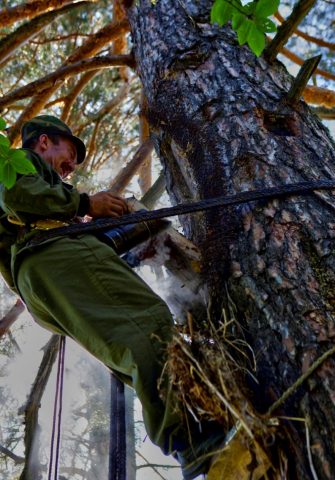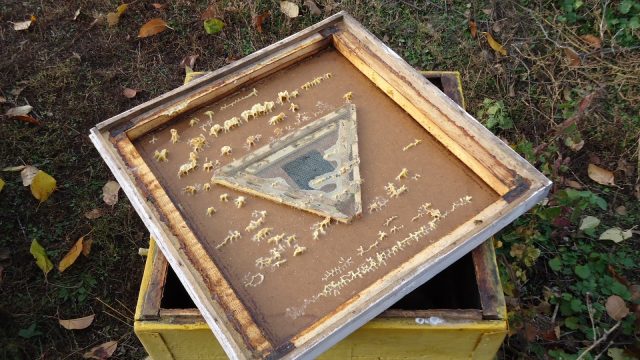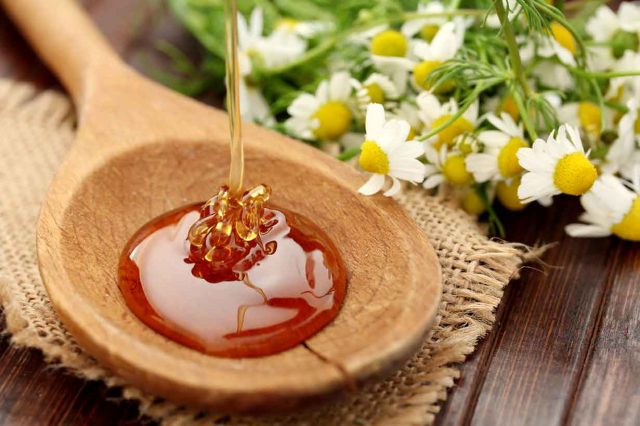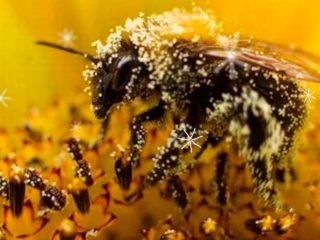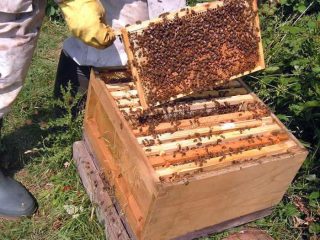Content
Honey collection is an important final stage of the apiary's work throughout the year. The quality of honey depends on the time it is pumped out of the hives. If picked too early, it will be unripe and will turn sour quickly. An unripe product contains a lot of water and few enzymes. Honey can be collected from wild or domestic hives.
Is it possible to collect honey from wild bees?
In nature, honey is produced by bees and bumblebees. The bumblebee product has a thinner consistency, slightly different in composition (less minerals, sucrose), and is not stored for long, only in the refrigerator. Bort (wild) honey does not contain artificial impurities, so it is often recommended for the elderly, children, and the sick.
Differences between on-board honey and homemade honey:
- density is higher;
- sweet, tart taste;
- amber;
- smells of herbs, wood, resin are felt;
- contains impurities of bee bread, wax, propolis;
- not easy to assemble;
- high price (due to complex collection).
Taking honey from wild bees is called beekeeping. Bort is the internal cavity of a tree trunk where insects build their hives. Often beekeepers have to create artificial sides and attract bees there (it is more convenient to collect the product from such sides).It is difficult to collect wild honey; beekeepers are only able to extract a small amount of it, which is why the cost of such a product is higher.
How to take honey from wild bees
Beekeeping is a dying craft. The secrets of craftsmanship are carefully passed on to future generations. You can only learn how to collect honey correctly from a practicing beekeeper: there is no special training.
Collection tools are made in a handicraft way - by hand. Kiram is a leather braided rope that helps to climb a trunk, its length is up to 5 meters. Batman is a hollow made from a single linden trunk. Lyange is a portable side, secured with a kiram, allowing the beekeeper to stand while collecting.
Little workers are calmed down with smoke so that they do not attack. Previously, brooms were used from dry and wet branches and leaves. Today, beekeepers use a fumigator. The tap hole and all cracks are treated with smoke. Then they open the side, that is, remove the dolzhei (“doors” of the hive in the form of a narrow long hole). Using a fumigator, insects are moved to the upper part of the hollow. Only after this can you take honey from the hive. Details about how to collect the product from wild bees are described in the video:
The honeycombs are cut with a wide wooden knife and placed in a batman. You cannot take all the honey from the bees - they feed on it in winter. They also leave part of the comb next to the entrance (at the bottom) to preserve the natural insulation of the nest. You need to assemble carefully: do not damage the remaining honeycombs. From one side you get from 1 to 15 kg of product. The time chosen is warm - August or September.
When honey is taken from bees in the apiary
Collecting honey is the main purpose of creating apiaries.Constantly collecting product from the honeycomb stimulates the bees and forces them to collect more nectar. To pump out honey from the hives, the beekeeper needs to make sure that the honey is ripe - there is no need to collect unripe honey: it will quickly deteriorate and turn sour.
The process begins at the end of the season, when insects finish collecting nectar. After this, they need to rest and seal the remaining frames. You can collect honey from bees after 5 - 7 days.
Honey is pumped from the bee hives early in the morning - in the evening the bees gather in the hive, so do not disturb them. In a small apiary, collection can be carried out during the daytime.
Honey is collected in some regions up to four times per season. It is first collected from May to August. The time depends on the flowering period of the plants from which the bees obtain nectar. For example, buckwheat and linden honey can be collected from late June to mid-July. Beekeepers focus on insect behavior.
The time of the last collection depends on the condition of the bee colonies and the climate of the region. It is advisable to complete the collection before the end of August. September is the last month. Next, the insects prepare for winter, and it is not recommended to disturb them. Every beekeeper should know and be able to know how to properly remove honey from a hive.
How to take honey from a hive
Pumping out honey with a standard manual honey extractor takes a lot of time. A novice beekeeper from 2 pm to evening will be able to process no more than 50 ordinary frames. And this is if you don’t stop for a minute.
Preparation begins the day before. The equipment is washed, treated with boiling water and left to dry. Then the mechanism is lubricated with oil, and the residue is removed with a rag.Prepare the tools. Standard set:
- table (where the honeycombs are unpacked);
- knife (standard, steam or electric will do);
- honey extractor with radial or chordial action;
- cart;
- box for cut parts;
- pump pumping out honey;
- feather, blower, brush (to brush away bees);
- containers for collecting the finished product.
Prepare the room: it should be clean and have access to water for periodic hand washing. The frames are removed after lunch, folded for transport, and covered with cloth to keep bees away from them. The honey is pumped out immediately - it must not be allowed to cool, otherwise the frames will have to be heated.
Before pumping, the wax caps are cut off. Use a fork and a hot knife. The finished frames are placed in a honey extractor. Rotate slowly at first, then gradually increase the speed. Having pumped out about half of the healthy treat, the frames are turned over and half is taken away again. Turn it over again and pump it out completely. Treat each side twice, about 10 minutes.
The resulting product is poured into containers and closed. The vacated frames are left to dry. They begin collecting from the next hives.
How to pump honey in multi-hull hives
The collection of honey in double-hull and multi-hull hives differs from the collection in simple hives. In addition to the standard set of tools, you will need a remover with a Hahnemann (separation) type grid. Experienced beekeepers consider such a grid indispensable. The device protects the queen and does not allow her to fly out in the absence of the beekeeper.
The removers are installed the night before. It is important that there is no brood in the hive at this moment. When collecting honeycombs, the frames are removed and the worker bees are shaken off (the remaining bees can be collected with a brush with wet bristles).
The seized frame is inspected. If there is brood inside, you should return it to its place and collect it next time: hasty collection can lead to the death of the brood, even if it is sealed. After removing the frames, the hive is closed and collection begins with the next one.
What methods exist
Collecting honey from honeycombs is a responsible task. Until 1865, collection was carried out using one single method: the honeycombs were placed under a press, and the resulting impurities and debris were removed through gauze. Modern beekeepers use various types of honey extractors.
To start collecting, the honeycombs should be printed. This is done manually or with special automatic devices. For small farms, forks (cut off the top, sealing layer) or a roller with needles (pierces the bar) are suitable.
The extraction technique depends on the type of honey extractor. The essence of the mechanism is that under the influence of centrifugal forces, honey comes out of the honeycomb, small drops fall on the walls of the device and flow into a special container. Honey extractors work in horizontal and vertical positions. Horizontal models operate radially or chordally.
How is honey stored?
Honey is a product that can be stored for a very long time. It is not difficult to provide the necessary conditions. Store in the refrigerator at home: recommended temperature is from 0 °C to +20 °C. At higher or, conversely, lower temperatures, beneficial substances begin to decompose.
The jars should not be exposed to direct sunlight. It is prohibited to place toxic objects nearby. It is important to keep it away from children, since exceeding the daily dose of the treat causes allergies, diarrhea and other pathologies.
Different containers are used.Glass jars, plastic containers, enamel, wood and earthenware - any type will do, as long as the right external conditions are created. Storage in honeycombs is considered the most suitable (they also require separate containers).
In terms of shelf life, the product is considered indefinite. GOST defines a period of 2 years - subject to compliance with storage standards. Beekeepers know very well that this is a suspended sentence. High-quality honey is stored for several years and does not lose its taste, color, or beneficial properties.
Interesting! About ten years ago, a container containing sealed honey was discovered in the tomb of an Egyptian pharaoh who was buried more than two thousand years ago. Archaeologists claim that the delicacy has not lost its taste or color.
Crystallization is a natural process after collection. This does not affect the usefulness in any way. Such honey is not considered spoiled.
The main signs of a good product:
- the ripened delicacy is wrapped around a spoon, stretches continuously, and forms a mound on the surface;
- does not foam (foam means that the product has fermented or is not ripe);
- There are no delaminations inside.
Conclusion
Collecting honey is a responsible process. Failure to comply with the technique can lead to the death of hives, deterioration in the health of bees and, as a result, a decrease in honey production in the next season. Each beekeeper needs to prepare for collection in advance: purchase equipment, become familiar with the procedure and rules. Beginners should turn to more experienced colleagues and assemble the product under their strict guidance.The result of the effort and time spent will be a high-quality, sweet and healthy product with a long shelf life.



